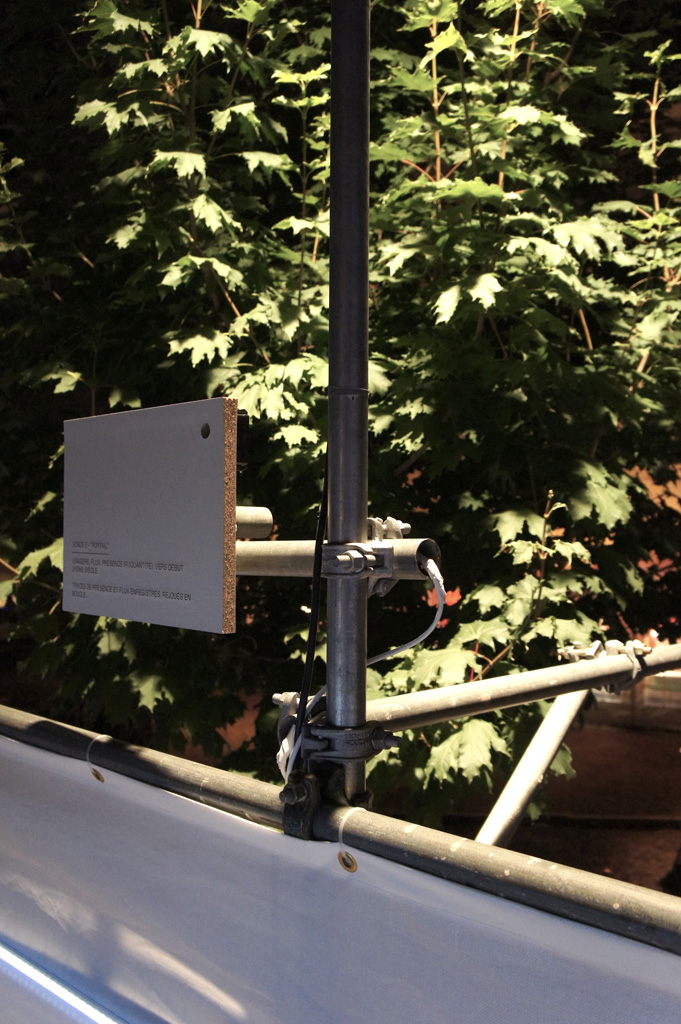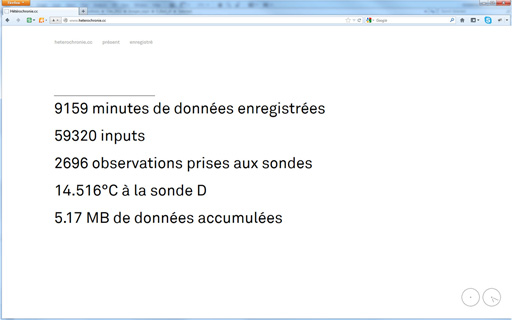By fabric | ch
-----
Heterochrony is a temporary architectural installation and new project designed by fabric | ch, office for architecture, interaction & research. It has been recently completed, exhibited and lived last Summer during the Festival de la Cité 2012, in Lausanne.
Heterochrony consists of a 40m long passageway architecture, or rather an "archaeological" observation deck: an architectural device that overlooks a public park (existing), that paradoxically connects its entrance directly to the exit -- so to have the opportunity to become an "observer " of what is happening in the park and walk through the square without really entering it, like in archaelogical gangways -- ... , that opens to contrasted atmospheres and try to reorganize the different spaces/common uses on the ground with a minimal physical touch and a maximal visual transparency.
The peculiarity of the project consists in the fact that it also tries to generate a dual perception and a temporal disruption, which leads to the title of the work, Heterochrony: if the present time of the park and its users is in fact the "archeology" to be observed and monitored from the deck, as well as recorded on the project's servers, and therefore a potential "past", then the present time of the passageway would become a possible "future", viewed from the ground ... It's an attempt to materialize such a mysterious temporal zone, induced by the combination of two different referentials in the same space.
The architectural device itself (the deck architecture) is equipped in five selected areas (observation points) with many multisensory monitoring devices. The sensors record as much data as possible over time, these being generated by the ever changing conditions, presence and uses in the park (its climate, atmosphere, molecular and gas composition, sounds, users, usages). The data are then stored on Heterochrony's servers and endlessly replayed in loops, on the computers, in the form of bits of information, as part of the overall architecture. It is a "recorded moment", in some ways "frozen" on data servers, and that potentially replays itself forever, or that is waiting for somebody to reacivate it.
The data are kept publicly accessible on the servers, with the utopian aim that they could allow to regenerate the "present" in another time (if a present, indeed, can still be identified within this project), thus reinforcing the feeling of time disruption about the place. A "control room" on the deck, with its set of interfaces and visualizations screens, let the visitors-observers follow the process of recording.
The work could be considered as an architecture proposal that is built upon the idea of a massive production of data that will very soon come out (be monitored) from our environment, be stored, mined (for whatever -- good or bad -- immediate, near and far future uses). Every second, our world and lives are producing/will produce massive amount of data, stored "forever" in some distant data centers, like millenia old bubbles of gas trapped in the ices of the polar caps... The project can undoubtedly be seen as a reference to the novel of A. Bioy Cassares, The Invention of Morel that resonates with the idea of monitoring/recording the real (and also to some extent to the recent "The City and the City", by China Miéville, for its dual and densified space).
As so, the project tries to introduce a doubt about its true nature: would it be in fact possible that what is observed from the platform is already a recorded present from the past? A ghost situation? A present regenerated from the recorded data by an unknown scientist, or maybe by the machine itself (the architectural recording device) and that would in fact also endlessly run in loops, for years?
-



An "observer" at two different "observation points", overlooking the surrounding environment and while doing so, triggering unwittingly the illumination of a strong projector on the park and its users, as well as the the recording of dedicated data.
" Two distinct times, two "presents" were observing each other, close to one another: the present of a public park with its "scene", its "garden", its "bar", its "festival-goers" and the present of a second place, the footbridge or "almost archeological" path that overlooked the whole, allowing to openly structure, observe, sense and record it.
Seen from this observation platform, a possible scientific device equipped with a multitude of presence detectors, of atmospheric and gas sensors, the present time of the park and its users seemed to be situated in an indefinite past, or maybe in a parallel present, at a different time. Or was it rather that all these recorded events were replaying in loops, for a long time?
The traces left by comings and goings, the ones of the molecules of the "party" and the present moment had indeed been monitored and recorded, stored and kept indefinitely on a data server, somewhere, for a utopian future, or past, replenishement. (...)"
-
"Deux présents distincts se frôlaient et s’observaient : le présent d’un parc public avec sa « scène », son « jardin », son « bar », ses « festivaliers », et le présent d’un second lieu, la passerelle ou le cheminement « presque archéologique » qui surplombait l’ensemble, l’articulait et permettait de l’observer, de l’enregistrer. (…)
Perçu depuis cette plateforme d’observation, probable dispositif scientifique équipé d’une multitude de sondes de présence, de capteurs atmosphériques et gazeux, le présent du parc et des ses usagers semblait se situer dans un passé indéfini, ou peut-être dans un deuxième présent, à un autre moment. Ou simplement les événements s’y rejouaient-ils en boucle, depuis longtemps ?
Les traces de va-et-vient, celles des molécules de la « fête » et de l’instant présent y avaient en effet été enregistrées, analysées, stockées pour une durée indéterminée sur un serveur de données, en vue d’une utopique reconstitution future, ou passée. (…)"




The passageway architecture over the park, with observation points, probes, strong spot lights to illuminate the observed areas. The deck organizes semi-fluid areas in the square with dedicated pop-up uses over time (a bar, a scene, a park, a street). Each of this areas/functions is topped by an observation point on the deck.

.jpg)
Inside the observation deck, a long central pathway connecting the entrance of the square to its exit, with radiating paths to observation points or to the "control room".

The overall lighting of all led bars is driven by data analysis: the lights on the platform behave like a data graph in the sense that the more data collected in an area (observation point), the stronger the lighting. But the overall lighting remains stable, meaning that the data mitigate the intensity of lighting of the different areas. At some time (every three hundred inputs), a "glitch" happens in the lighting to resynchronyse and reset everything.




Observation points on the deck, with their spot lights (oriented toward the surrounding environment) activated by the presence of observers which also triggers the recording of the data on the servers. The probes that equip each observation point are equipped with presence, molecular and gas composition, temperature, humidity, pressure, light and noise sensors, as well as titling pannels about what is seen, observed and replayed in loops (?) ("(...), around the beginning of the 21st century").
.jpg)


.jpg)
"Control room" with interfaces, live data variations and visualizations.




The website of the project remains accessible and the recorded data downloadable (www.heterochronie.cc). It runs now in loops, endlessly replaying the weeks duration that lasted the experience.





Pictures: Nicolas Besson, David Colombini, Patrick Keller.
--------------------------------
Project: fabric | ch
Project team: Patrick Keller, Christian Babski, Christophe Guignard, Stéphane Carion, Nicolas Besson, Sinan Mansuroglu, David Colombini, Maxime Castelli.
Software development: fabric | ch, Computed · By
Structure: PCM Échafaudages SA
Curatorship: Michael Kinzer, Annedominique Chevalley
With the support of Loterie Romande, Pro Helvetia, Ville de Lausanne, PCM Échafaudages, HGC Commerciale & Computed·By








.jpg)





.jpg)


.jpg)









